AN INTERVIEW WITH SCOTT WALLACE, AUTHOR OF THE UNCONQUERED
The world is more interconnected than ever. Globally, there are six billion cell phone subscribers and a billion Facebook users. Nearly 32 million people follow Lady Gaga on Twitter. Given this content it may seem hard to believe that there remain people who have never had contact with the outside world. Yet such people do exist today. Most of them live in the most remote parts of the world’s wildest forests.
One of this year’s best paperback books takes a close look at one uncontacted group — the Arrow People of the Brazilian Amazon. Written by veteran journalist Scott Wallace, The Unconquered: In Search of the Amazon’s Last Uncontacted Tribes is a gripping first-person account of a journey to learn more about this little-known tribe. Wallace’s tale is one of adventure, complete with danger, intrigue, and a remarkable cast of characters, the most memorable of whom is Sydney Possuelo, the expedition’s leader and a real-life Indian Jones. As an “agent of contact” for Brazil’s National Indian Foundation, Possuelo was responsible for determining what actions to take with uncontacted tribes across the Amazon.
Since its release in 2011 The Unconquered has won wide acclaim. It was just named one of the Top Ten Literary Travel Books of 2012 by Booklist and recently received a Lowell Thomas Award from the Society of American Travel Writers. Wallace just received the Explorers Club’s Lowell Thomas Award for his work in the Amazon.
In December 2012, Wallace answered some questions from mongabay.com about the book, his career path, and uncontacted tribes in the Amazon and beyond.
MONGABAY Q&A WITH SCOTT WALLACE, AUTHOR OF THE UNCONQUERED: IN SEARCH OF THE AMAZON’S LAST UNCONTACTED TRIBES
Mongabay.com: What sparked your interest to become a journalist? And why the Amazon?
 |
Scott Wallace: It started long ago, when I took a year off college. I went first to Mexico to study Spanish for the summer, then continued overland to Peru, where I’d lined up a volunteer job to teach literacy in an indigenous community in the jungle. That turned out to be a pivotal experience. In the years that ensued, I became intensely interested in what was going on in Latin America. I decided to become a journalist to cover Latin America, because it best matched my passion for travel, adventure, storytelling and photography. After graduating from journalism school in 1983, I went straight to El Salvador and got my start in the profession with a baptism of fire, you might say. I spent seven years in El Salvador, Nicaragua, Guatemala and Panama covering the upheaval of the 1980s that culminated with end of the Contra War in Nicaragua and the U.S. invasion of Panama.
I eventually looped back to the Amazon. By the early 1990s, I’d become increasingly interested in the environment and the struggle over land and resources on the planet’s remote frontiers. That earlier experience in the Peruvian jungle had stayed with me and called me back. There was something about the utter rawness of the place, its awe-inspiring and terror-inducing wildness that appealed to me. And the events unfolding there now are of critical importance to all of us, to the survival of the planet. So it’s a place that tests my abilities and where my previous experiences and cumulative knowledge enable me to move around and perform with some degree of competence.
Mongabay.com: What’s been the response to The Unconquered? Any major surprises?
 |
Scott Wallace: I’ve been speaking on college campuses, to civic groups and to the directors and donors of nonprofits, and the level of engagement people have with this subject of uncontacted tribes has been overwhelming. I think there’s something that fires the imagination and raises the morale of everyone to hear the message of the uncontacted tribes – that there still are people who have chosen a different path from the rest of us, that there are still populations and communities out there to maintain a deep connection to an ancient past that we’ve all come from.
Mongabay.com: What were the biggest challenges on your search for evidence of the Arrow people?
Scott Wallace: Perhaps the biggest challenge of all was simply accessing this almost impenetrable terrain where the Arrow People hold forth. Nearly all the remaining uncontacted tribes in the Amazon, including the Arrow People, have retreated into the rainforest’s most inaccessible redoubts. We’re talking about an area of very rugged and densely forested headwaters. There are hazards at every step, really, from thorned trees that could impale an eyeball in a moment of carelessness to a repertoire of highly venomous serpents – bushmasters, fer-de-lances, coral snakes. We had to cross dozens of streams and rivers, sometimes traversing long, slippery log bridges that focused your concentration to the fullest. Slipping off one of those logs could have resulted in serious injury, and in closed canopy forest, evacuation was not an option.
Apart from those dangers, the other main challenge was to gather information about a people whom you do not actually want to meet. We entered the land of the Arrow People to gather information about the extent of their wanderings – observing and documenting their abandoned fishing camps, their migration routes, artifacts that they would leave in their annual wanderings through the forest. But such an undertaking always implied the risk of violent encounter in the depths of the jungle. It made for a strange and dangerous dance – to seek out the Arrow People even while trying to avoid them.
Mongabay.com: The area you entered is one of the most remote in the Amazon (and therefore the world). What can you tell us about entering a place so far from civilization? Any adventures you’d like to recount?
Scott Wallace: I was happy to have been in the company of a large contingent of indigenous scouts and backwoodsmen to enter the remote Amazon. It’s so wild, so remote, and everything is on such a grand scale that the experience is truly humbling – and frightening. We in modern urban society are so used to getting whatever we want at the push of a button. Well, life didn’t used to be that way for 99 percent of our history, and it still isn’t that in the Amazon. Everything requires an effort, from finding your next meal to making sure your very next step isn’t going to land you in an ankle-twisting hole or on top of a deadly snake. The indigenous people who live there have evolved a way of life and a culture that allow them to move with ease through what is for us this strange and terrifying place. The constant downpours, the mud, the constant dampness and maddening swarms of insects don’t bother them in the least. We would have been completely lost without them.
Mongabay.com: Sydney Possuelo sounds like a fascinating character. What do you think drives him?
Scott Wallace: Sydney Possuelo was the leader of our expedition, the main character of The Unconquered and the founder of Brazil’s curiously named Department of Isolated Indians within FUNAI, the country’s Indian affairs agency. Possuelo is one of those rare individuals who believes absolutely in what he’s going and will go to any lengths to get it. He’s an idealist who was able, almost single-handedly, to shift Brazilian government policy toward its indigenous people in general and toward its isolated and uncontacted indigenous groups in particular. He displays a single-mindedness that I found both admirable and disconcerting. I think he’s truly motivated by a deep humanitarian impulse to defend the underdog, to protect and give voice to some of the most marginalized people on Earth.
Mongabay.com: There’s a sentiment in some circles in Brazil that indigenous populations have already been allocated too much land (there’s an idiom something like “a lot of land for a few people”). Did you encounter that argument much during your research or experiences in the field? Who tends to feel that way? What are their arguments?
Scott Wallace: Placing indigenous lands beyond the reach of loggers, settlers, mineral prospectors and land speculators is a very unpopular policy on the frontier. In the face of widespread discrimination and loathing among colonists rich and poor along the frontier, indigenous people have forged alliances in recent years with foreign NGOs to defend their lands and rights. This has, in turn, lent weight to arguments put forth, rather cynically, by powerful industrialists and their political minions that a conspiracy of foreign interests is seeking to “internationalize” the Amazon and grab its resources.
Mongabay.com: Since you made your journey into the forest, there has emerged a strong push to scale back some of Brazil’s protections for the Amazon and indigenous territories. For example, the ruralistas in Brazil’s Congress have pushed to weaken the Forest Code and are now moving to give development interests like mining and construction companies rights to operate in indigenous territories. Do you see threats to indigenous lands in Brazil increasing in the future or is the situation for uncontacted tribes in Brazil stabilizing, especially in the context of what’s happening in places like Peru and Paraguay?
Scott Wallace: The threats to indigenous lands in Brazil and elsewhere in the Amazon continue to grow. While Brazil maintains an enlightened policy toward the uncontacted and isolated indigenous people of the Amazon, the macroeconomic policies pursued by the government of Dilma Rousseff pose a great challenge and threat. She has in essence hitched her fortunes to investing in huge mega-construction projects in the Amazon, such as the highly controversial Belo Monte dam. There are several other major hydroelectric projects under construction in the Amazon. Together, they threaten to transform the region, drawing migration from other parts of Brazil, taxing the resources and devouring the land. I am not optimistic.
Mongabay.com: Is contact for these tribes inevitable, i.e. a matter of time in our rush for the world’s remaining resources? Is it really possible in this day and age for these tribes to remain untouched by the modern world?
Scott Wallace: I would like to think that we could find a way to protect at least a few of the world’s last great wild place, including the people who choose to live there, in isolation from the rest of us. But our greed and our covetousness seem to know no bounds. Left to our baser instincts, we will overrun every last spot of pristine wilderness to get at the resources they harbor. Clearly, the only way these regions will be protected – and the self-determination of the people who live there respected – by maintaining constant, willful vigilance. Laws to protect the isolated tribes must be passed. Where such laws are already on the books, we must insist on vigorous enforcement. Only the rule of law can succeed in protecting these lands and the people who live there.
Mongabay.com: If disease were not a concern, some may argue that contacting a tribe such as these would bring untold benefits to them in time, i.e. better living standards, modern health care. What do you say to this?
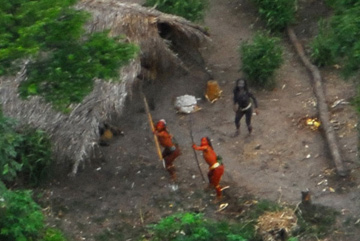 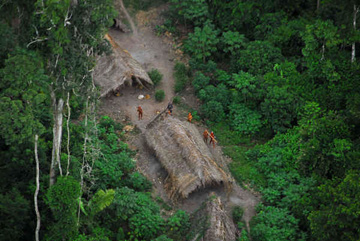 Photos of an uncontacted tribe in the Terra Indigena Kampa e Isolados do Envira, Acre state, Brazil, near the border with Peru, caused a stir when they were released by Survival International, an NGO, in May 2008. The indigenous group is said to be threatened by oil exploration in the area. © Gleison Miranda/FUNAI. |
Scott Wallace: Time and again, we have seen the opposite. In our arrogance, we assume that what we have is better than what these ancient cultures already have. Naturally, it’s better for us. But is it really better for them? The people who have intact wilderness, whose rivers are clean and teeming with fish, whose forests are unscathed and filled with animals, have everything that they need. They have health and a sense of purpose and community. They might exist on a mere fraction of the resources we consume, but that doesn’t mean they’re worse off or even that they’re impoverished.
But the question also presupposes that such groups would somehow receive the benefits of society reserved for the privileged classes. How many people in India or Sierra Leone are receiving the benefits of modern civilization? How many tribal groups in the Amazon have truly benefited from modern health care? The sad fact is that once these groups are contacted, they soon find themselves occupying the lowest rungs of our society, marginalized and despised. I truly believe they’re better off without us. So too does Possuelo.
Mongabay.com: What threatens this particular tribe?
Scott Wallace: The Arrow People are facing no direct threats at the moment. They have the good fortune of inhabiting one of the best protected areas in the entire Amazon. But their lands are potentially vulnerable to incursions from loggers and wildlife poachers. All it takes is one clash and a few casualties to trigger an escalation that could lead to a well-organized, genocidal raid that wipes out an entire village. We have an abundance of examples from our own history in North America to know that this has to be an ever-present danger for every uncontacted tribe still out there in the Amazon today.
Mongabay.com: How many uncontacted tribes are left in the world?
Scott Wallace: We don’t know for sure. There are two uncontacted indigenous groups holding forth in the Andaman Islands in the Indian Ocean. There may possibly still be a group or two in New Guinea, but probably not. The Amazon is really the last place on Earth where there is an abundance of such groups. We know of close to 30 in Brazil and there may be more, 15 in Peru, two groups in Ecuador, two in Bolovia, a handful in Colombia and perhaps one last group of isolated Yanomami in Venezuela. So all told, there may be 60-70 such groups.
Mongabay.com: Did you speak with contacted tribes about their sentiments toward uncontacted tribes?
Scott Wallace: The attitude of contacted tribes toward their uncontacted brethren is curious. In some instances, they look down on the uncontacted groups. Perhaps because they’ve internalized the mentality of their oppressors, they see the uncontacted groups as wild, untamed, primitive. But in other instances, the contacted groups revere the uncontacted. In Ecuador, for example, there are still a number of clans of Waorani that remain uncontacted, wandering the forests as nomads. Their contacted relatives derive a sense of tribal identity and resistance from their uncontacted brethren. They see themselves as the protectors of the uncontacted groups. I think their tribal identity and morale would suffer a terrible blow if outsiders forced contact on their reclusive relatives. So it depends a great deal of which groups you’re talking about.
People in the cities have no clue that there are still uncontacted groups out in the forest.
Mongabay.com: Research has shown that indigenous lands maintain forest cover better than some conservation areas in Brazil. Do you see any prospect of tribes benefiting from conservation funds, either directly as “conservation rangers” or indirectly under an argument that this uncontacted tribe’s land provides a certain value of services to mankind?
 |
Scott Wallace: This is an argument to be made in favor of protecting the lands of uncontacted tribes. By virtue of its mission to protect the uncontacted tribes of Brazil, the Department of Isolated Indians is protecting 50,000 square miles of pristine wilderness. That’s an area the size of New York State. The policy of protecting the uncontacted tribes is where the cause of human rights meets the cause environmental conservation. The only way to protect these isolated groups is by protecting the rainforests in which they live.
Mongabay.com: Any tips for aspiring journalists?
Scott Wallace: Follow your dreams and your passions. Study history and English and languages. Open your heart to the world and go out and discover it.
Related articles
Photos: Uncontacted Amazon tribes documented for first time in Colombia
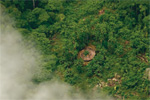
(04/19/2012) Aerial surveys of a remote area of rainforest along the Colombia-Brazil border have produced the first photographic evidence of uncontacted tribes, according to a conservation group that works to safeguard indigenous territories and culture. The photos, released by the Amazon Conservation Team (ACT), show five long houses or malokas thought to belong to two indigenous groups, the Yuri or Carabayo and Passé, some of the last isolated tribes in the Colombian Amazon. The images provide confirmation that uncontacted communities still exist within the Rio Puré National Park, which protects a million hectares (2.47 million acres) of mostly pristine rainforest between the Caquetá and Putumayo River basins along the Brazilian border.
Isolated indigenous people and tourists collide in Peru park
(10/19/2011) New video released by the Peruvian government shows a potentially disastrous encounter between tourists and indigenous people long isolated from the outside world. In a motor boat tourists follow a group of Mashco-Piro people walking along the shores of the Manu River in Manu National Park. At one point one of the tribal members prepares to fire at the boat with an arrow. But danger doesn’t only come from the possibility of a violent clash: uncontacted indigenous people, those who have chosen isolation from the world, are incredibly susceptible to disease.
Brazil confirms existence of new uncontacted Amazon tribe
(06/22/2011) The Brazilian government confirmed the existence of a community of uncontacted Amerindians in a protected area near the Peruvian border, reports Funai, Brazil’s Indian affairs agency.
Incredible new photos of uncontacted tribe in the Amazon
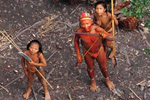
(01/31/2011) Taken by Brazil’s Indian Affairs Department and released by indigenous-rights group, Survival International, new aerial photos show an uncontacted tribe on the border of Brazil and Peru in detail. According to a press release by Survival International, the photos “reveal a thriving, healthy community with baskets full of manioc and papaya fresh from their gardens”, but a community that is also threatened by illegal loggers from Peru.
Spanish oil company develops own rules for contacting uncontacted Amazon tribes
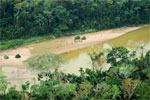
(03/26/2010) Imagine you’re in one of the remotest parts of the Amazon rainforest and suddenly you come across members of an uncontacted tribe. What should you do? The experts say, “Turn around. At all costs, make no attempt at contact.” Repsol YPF, exploring for oil in northern Peru, has taken a different approach. Despite the extreme vulnerability of the tribes to any form of contact, the company suggests that its workers talk to them in certain instances, and even provides specific phrases to use and conversation topics to address.